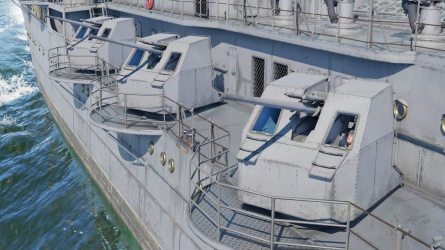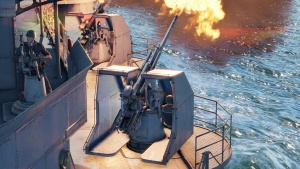65 mm/64 Ansaldo-Terni Mod.1939 (65 mm)

Contents
Description
65 mm/64 Ansaldo-Terni Mod.1939 is an Italian high-calibre, long-range anti-aircraft gun, combining an excellent rate of fire with great vertical guidance and high muzzle velocity.
Vehicles equipped with this weapon
General info
Available ammunition
| Penetration statistics | |||||||
|---|---|---|---|---|---|---|---|
| Ammunition | Type of warhead |
Penetration @ 0° Angle of Attack (mm) | |||||
| 100 m | 1,000 m | 2,000 m | 3,000 m | 4,000 m | 5,000 m | ||
| HE-TF Contro Aerea | HE-TF | 8 | 8 | 8 | 8 | 8 | 8 |
| HE Dirompente | HE | 8 | 8 | 8 | 8 | 8 | 8 |
| Shell details | ||||||||||||
|---|---|---|---|---|---|---|---|---|---|---|---|---|
| Ammunition | Type of warhead |
Velocity (m/s) |
Projectile mass (kg) |
Fuse delay (m) |
Fuse sensitivity (mm) |
Explosive mass (TNT equivalent) (g) |
Ricochet | |||||
| 0% | 50% | 100% | ||||||||||
| HE-TF Contro Aerea | HE-TF | 950 | 4.08 | 0 | 0.1 | 450 | 79° | 80° | 81° | |||
| HE Dirompente | HE | 950 | 4.08 | 0 | 0.1 | 450 | 79° | 80° | 81° | |||
Comparison with analogues
| Cannon | Sample Ship | Ammo | Calibre (mm) |
Muzzle Velocity (m/s) |
Sustained rate of fire (rounds/min) |
Targeting speed (°/s) |
TNT Equivalent (kg) |
Penetration @ 0° Angle of Attack (mm) | ||||
|---|---|---|---|---|---|---|---|---|---|---|---|---|
| Horizontal | Vertical | 1,000 m | 5,000 m | 10,000 m | ||||||||
| 65 mm/64 Ansaldo-Terni Mod.1939 | RN Etna | HE-TF | 65 | 950 | 30 | 15 | 22 | 0.45 | 8 | 8 | 8 | |
| 3 inch/23 Mk.4 (76 mm) | USS Barker | HE-TF | 76 | 503 | 9 | 8.5 | 13 | 0.34 | 7 | 7 | 7 | |
| 3-inch Mk.34 (76 mm) | USS Roanoke | HE-VT | 76 | 823 | 6 | 20 | 26 | 0.3528 | 7 | 7 | 7 | |
| 88 mm/45 SK L/45 (88 mm) | Drache | HEF-I | 88 | 823 | 14 | 8.5 | 8.5 | 0.698 | 11 | 11 | 11 | |
| 39-K (76 mm) | Tashkent | HE-TF | 76 | 810 | 20 | 18 | 11 | 0.182 | 5 | 5 | 5 | |
| 34-K (76 mm) | Moskva | HE-TF | 76 | 810 | 27 | 12 | 8 | 0.182 | 5 | 5 | 5 | |
| Type 88 AA (75 mm) | Type 5 | HE-TF | 75 | 720 | 20 | 21 | 20 | 0.42 | 7 | 7 | 7 | |
| 8 cm/60 Type 98 (76 mm) | IJN Agano | HE-TF | 76 | 902 | 25 | 18 | 16 | 0.399 | 7 | 7 | 7 | |
| 75 mm/50 model 1922 (75 mm) | Primauguet | HE | 75 | 850 | 15 | 19 | 18 | 0.45 | 8 | 8 | 8 | |
Usage in battles
65 mm/64 Ansaldo-Terni Mod.1939 is an exceptional high-calibre anti-air gun. With 80° vertical guidance, it can intercept enemy dive bombers, while its high rate of fire (one shell every 2 seconds) increases the chance to hit the enemy. Being such a high calibre gun, AI will engage enemy airplanes from a very long distance, passively discouraging enemies from even approaching your vessel.
Pros and cons
Pros:
- Rate of fire
- Muzzle velocity
- Explosive filler
Cons:
- No access to HE-VT shells
History
65 mm was the calibre of choice for the new semi-automatic cannon of choice for the Italian vessels introduced during the WW2. The design of the 65 mm/64 originated from the collaboration between Ansaldo and Tenri, which begun in 1939 and continued until armistice in 1943, when the gun was cancelled before entering the mass production.
Initial prototypes had a gun length of 56 calibres, but in pursuit of performance, the barrel was extended to 62 and eventually 64 calibres. The challenges with development and pursuit for perfection at the expense of time and budget lead to eventual suggestion being put forward to eliminate the autoloading mechanism.
The first vessels planned to use the gun were the Capitani Romani-class cruisers, but due to delays the guns were replaced by readily-available 37 mm/54. The first production-grade 65 mm/64 were completed in Autumn 1943 and mounted on the RN Aquila, with further production stock being envisioned for RN Etna, but never actually delivered to the CRDA shipyard in Trieste.
To this date, a single 65 mm/64 survived in the Museo tecnico navale in La Spezia, it came from the Aquila carrier.
Media
Excellent additions to the article would be video guides, screenshots from the game, and photos.
See also
Links to the articles on the War Thunder Wiki that you think will be useful for the reader, for example:
- reference to the article about the variant of the cannon/machine gun;
- references to approximate analogues by other nations and research trees.
External links
- [Italian Wikipedia] 65/64 Mod. 1939
- [NavWeaps] 65 mm/64 (2.56") Model 1939
- The Weapons of the Italian Ships (Le armi delle Navi Italiane) by Erminio Bagnasco, page 71




